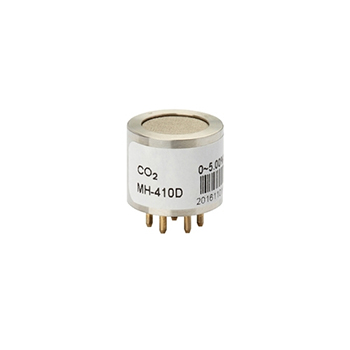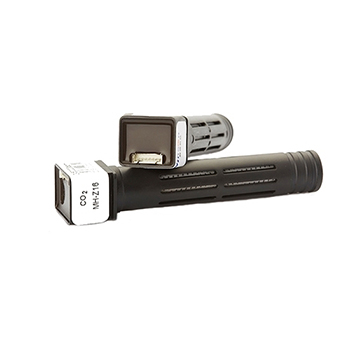How do You Calibrate a CO2 Sensor?
Any CO2 sensor needs to be calibrated before use to improve accuracy. So how much do you know about the calibration method of the carbon dioxide sensor? Next, let's learn the calibration knowledge of carbon dioxide sensors together.
Calibration method
Zero Point CO2 Sensor Calibration
Zero calibration exposes the sensor to 100% nitrogen. Since 100% nitrogen means no CO2 is present, a "zero point" can be updated in the sensor's internal memory. As the sensor ages, resetting the zero point will cause drift over time.
The advantage of calibrating a CO2 sensor with 100% nitrogen is that it removes any deviation from the sensor zero (0% CO2) as the sensor ages. The downside is that resetting the zero, while important, is not a full factory calibration. For this, a 2-point or span calibration is required.
Span CO2 Sensor Calibration
Span or 2-point calibrations are performed at the lowest and highest gas levels the product is rated for, typically using 0 ppm CO2 in 100% nitrogen, and a special gas mixture of nitrogen and CO2 called the calibration gas. Span calibration should be performed at the factory immediately after the CO2 sensor is manufactured by first exposing the sensor to a pure gas (such as 100% nitrogen), in the case of a CO2 sensor calibration, the sensor's 0 ppm CO2 reading is recorded in the sensor's memory.
Next, the sensor is exposed to the highest carbon dioxide level for which the sensor is rated. For example, a 5% CO2 sensor will be calibrated using a balance of 5% CO2 with the gas nitrogen or air. The sensor's response after exposure to a second known gas is also recorded in the sensor's memory.
Once you know the 2 points, you can assume a linear response to the gas concentration between the 2 points, which is called the calibration curve and is shown in blue in the image above.
3-point CO2 sensor calibration
Calibration is performed at the lowest, midpoint, and highest gas levels the product is rated for. For CO2 safety alarm calibration is performed at 0.0% CO2 level, default alarm 1 level, and default alarm 2 levels.
Function
Monitor CO2
Carbon dioxide is one of the raw materials for the photosynthesis of green plants, and 95% of the weight of crops comes from photosynthesis. Concentration control using carbon dioxide sensors is an important factor affecting crop yields.
The carbon dioxide sensor adopts new infrared verification technology to measure CO2 concentration. It responds quickly and sensitively, avoiding the lifespan and long-term drift of traditional electrochemical sensors. It is widely used in agricultural greenhouses, flower cultivation, edible fungus planting, and other occasions that require CO2 monitoring.
Testing for air quality and safety in new cars
In recent years, the development momentum of onboard sensors is booming, and various gas sensors such as NDIR CO2 sensors 0 to 5000 ppm, PM2.5 sensors, VOC sensors, and alcohol sensors are gradually integrated into cars. According to the specific use requirements, many mid-to-high-end models are equipped with gas sensors linked to the air-conditioning system, and there are many types of gas pollution detection products in the aftermarket, too numerous to enumerate.
Look for leaks
Use a smart carbon dioxide sensor to solve this problem. Different from the intelligent sensing system that detects gas types, the gas sensor array of this system is composed of several gas sensor elements with overlapping sensitivity, so that the sensitivity of the sensing system to a certain gas is enhanced. Using the computer to process the signal change of the gas sensor, the gas concentration change can be detected quickly, and then the leak point can be found according to the gas concentration change.
Prevent drift
Most CO2 products use non-dispersive infrared (NDIR) CO2 sensors. They rely on an infrared light source and detectors to measure the number of CO2 molecules in a sample between them. Over time, the light source and detector will degrade resulting in a slight decrease in the number of CO2 molecules. It's called "drift" in the industry.
To prevent sensor drift, during calibration, the sensor is exposed to one or more known gases containing varying amounts of CO2. When the sensor is initially calibrated at the factory, the difference between the new reading and the original reading is stored in EPROM memory. This "offset" will automatically increase or decrease any subsequent readings the sensor takes during use.
Precautions
- The infrared sensors need to be warmed up before use. Warming up is a process of stabilizing the optical system components inside the infrared sensor, enabling the sensor to achieve better test performance.
- In order to ensure the normal operation of the sensor, the power supply voltage must be kept within the specified range. If it exceeds the specified range, the sensor may malfunction, resulting in a low output concentration of the sensor or malfunction.
- The sensor should be kept away from heat sources, and avoid direct sunlight or other heat radiation. Do not use the sensor for a long time in an environment with high dust density.
- If the sensor needs to be placed in a narrow space, the space should be well-ventilated, especially the two diffusion windows should be in a well-ventilated position.
Application range
Carbon dioxide sensors have a wide range of applications, including the beer industry, carbonated beverage industry, coal mining industry, agricultural planting industry, agricultural breeding industry, and people's daily life.
Agriculture
The application of carbon dioxide sensors in agriculture is mainly reflected in the cultivation of agricultural greenhouses. Carbon dioxide is an important substance for the photosynthesis of crops. Installing a carbon dioxide sensor in the greenhouse can monitor the carbon dioxide content inside the greenhouse in real time. When the carbon dioxide content is too low, the sensor will send out a warning. At this time, we need to apply gas fertilizer in time to supplement the carbon dioxide content in the atmosphere, so as to ensure the good growth of the crops in the shed.
Industry
In carbonated beverage manufacturing, carbon dioxide is an essential gas that needs to be added to beverages. The use of sensors to detect whether the content of carbon dioxide in beverages meets the standards will help the production run smoothly. In the coal industry, carbon dioxide sensors can be used in underground coal mining operations. When the concentration of underground carbon dioxide is detected to be too high, it is necessary to adjust the air quality through wind ventilation in time to ensure personal safety.

